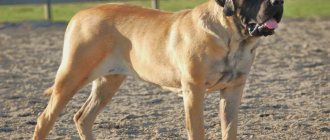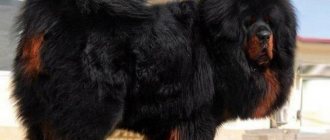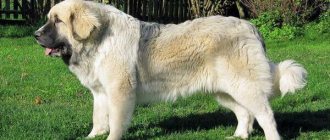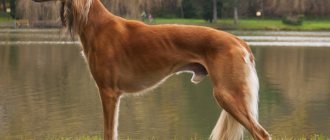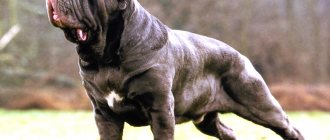Description of the breed
The Tibetan Mastiff is a strong and robust dog that is well built and has strong bones. Development occurs slowly: full maturity in females is achieved at 2 - 3 years, in males - not earlier than 4 years. External characteristics of the mastiff:
| Appearance | Characteristics |
| Head | powerful, heavy, wide. The fold goes from eye level to the corners of the mouth; |
| Scull | heavy, large, slightly rounded, the back of the head is pronounced. The stop is clearly visible; |
| Nose | dark, wide, nostrils well open; |
| Muzzle | wide, deep, well filled. At the end the muzzle is square; |
| Lips | pigmented, well hide the lower jaw, well formed; |
| Jaws | powerful, strong, correct bite: the teeth on top overlap the teeth below. The jaw shape is square. Direct bite possible; |
| Eyes | medium, brown, depending on coat color. The eyes are set wide, the shape is oval, slightly slanting. The eyelids fit well to the eyeballs; |
| Ears | the middle ones, in the shape of a triangle, are located between the line of the skull above and the line of the eyes. They fall down and hang close to the head; when the dog is alarmed, they are in the front; |
| Neck | muscular and strong, slightly curved. |
| Frame | strong, back straight and wide, muscular. The croup is flat but wide. The chest is of medium width, deep, the ribs are well formed. The chest is shaped like a heart; |
| Tail | medium, set high, in line with the level of the back. The dog carries it high, bends it freely behind its back while moving; |
| Forelegs | Well developed, curved, strong and muscular. Shoulders well set, forearms straight, bones well formed, ankles strong, slightly sloping; |
| Hind limbs | muscular, strong, curved. The thighs are strong and long, the muscles are well developed, strong, the hocks are strong, set low; |
| Paws | in a lump, large, round. |
The dog's movements are authoritative, flexible, the step is firm and confident. High speed of movement develops in a straight line.
SERVICES FOR DOGS AND THEIR OWNERS
Official FCI Tibetan Mastiff Standard
BREED STANDARD FCI No. 230/ 04/02/2004/
DO-HI
(TIBETAN MASTIFF)
COUNTRY OF ORIGIN : Tibet.
PATRONAGE : FCI .
PUBLICATION DATE OF THE VALID ORIGINAL STANDARD: 24.03.2004.
PURPOSE : The dog is a companion, guard and guard dog.
FCI CLASSIFICATION : Group 2 (Pinchers and Schnauzers, Molossians, Swiss Cattle Dogs and other breeds).
Section 2.2 (dogs such as Molossians and Mountain Cattle Dogs).
No operational tests.
BRIEF HISTORY OF THE BREED
: The Tibetan Mastiff (Do-Hi) is an ancient working breed that in ancient times served the nomads from the Himalayan mountains and Tibetan monasteries as a watchman and security guard. Since the first mentions, back in ancient times, this breed has always been surrounded by myths and legends. Aristotle (384 - 322 BC), Marco Polo, in his famous notes on a trip to Asia in 1271, as well as all other historical chronicles, glorify the physical and mental natural strength and power of Tibetan mastiffs. Even the bark of the Tibetan Mastiff is considered a unique and highly valuable trait of the breed. The most prominent dog experts of the past, such as Martin, Yuat, Mignin, Beckmann, Sieber, as well as Strebel and Bilandt, fascinated by the origin and place of the Tibetan mastiff in Tibetan culture, intensively studied it. There is an opinion that the Tibetan mastiff is the ancestor of all breeds belonging to the Molosser group. The first known Tibetan mastiff to reach Western shores was sent to Queen Victoria in 1847 by Lord Hardinge (later Viceroy of India). Later, in the 80s of the 19th century, Edward VII (the future Prince of Wales) took two dogs with him to England. And in 1898, an officially registered litter of Tibetan mastiff appeared in the Berlin Zoo.
GENERAL FORM
: Powerful, heavy, well-built dog with developed bones. Expressive, with an important and extremely serious expression in her eyes. Combines majestic strength, power and endurance; able to work in any climatic conditions. Full formation is achieved slowly: females - at 2 - 3 years, males no earlier than 4 years.
BASIC PROPORTIONS
:
· The length of the skull, measured from the back of the head to the stop, is equal to the length of the muzzle from the stop to the tip of the nose. But the muzzle may be a little shorter.
· The length of the body slightly exceeds the height at the withers.
BEHAVIOR/TEMPERAMENT
: Independent. Reliable defender. Demands self-respect. Maximally devoted to his family and his territory.
HEAD
: Wide, heavy, strong. In adult dogs, there may be a crease from the line above the eyes down to the corner of the mouth.
CRANIAL PART:
Skull: Large, slightly rounded, with a clearly defined occipital protuberance.
Stop: Well defined.
FRONT PART:
Nose: Wide, as dark as possible depending on the color, with well-opened nostrils.
Muzzle: Fairly broad, well filled and deep. The end of the muzzle is square.
Lips: Well developed and covering the lower jaw.
Jaws/Teeth: Jaws strong with a perfect, regular and complete scissor bite, i.e. The upper incisors fit tightly onto the lower incisors and stand vertically in the jaws. A level bite is acceptable. The teeth are tight.
Eyes: Medium size, any shade of brown or in accordance with coat color, darker ones are preferred. Well spaced, oval and slightly oblique. The eyelids fit tightly to the eyeball. With an expression of dignity.
Ears: Medium size, triangular, drooping, set between the level of the skull and the eye, falling slightly forward, close to the head. When excited, they rise up. The ears are covered with soft short hair.
NECK
: Strong, muscular, with a pronounced scruff. The suspension is small. The hair on the neck is thick, sticking out, and forms a mane; in females, it is not so pronounced.
FRAME:
Lasting.
Back: Straight, muscular.
Croup: Broad and fairly horizontal.
Chest: Quite deep, of moderate width, with ribs rounded at the top, giving the chest a heart shape. The lower part of the chest is lowered below the elbows.
TAIL
: Middle length. Set on high, on the top line of the back. When alert and in motion, the dog holds its tail high, loosely thrown over its back. Fluffy.
LIMBS
FOREQUARTERS: Straight, well angulated, covered with dense hair over the entire surface.
Shoulders: Well sloping, muscular.
Elbows: Turned neither in nor out.
Forearms: Straight. With strong bones.
Pasterns: Strong, slightly sloping.
HINDQUARTERS: Powerful, muscular, well angulated. Parallel when viewed from behind.
Thighs: Quite long, strong, with voluminous, strong, but not bulging muscles.
Knees: Well defined.
Hocks: Strong, low set.
Dewclaws optional.
FEET: Fairly large, strong, round and compact, with thick hair between well arched toes.
GAIT/MOVEMENT
: Powerful, but always light and springy: with good reach and push. As the speed increases, he moves his feet closer to the center line. Looks very leisurely in his step. Able to move on a wide variety of terrain, while showing endurance and agility.
COAT
WOOL: The quality of the wool is much more important than the quantity. The coat is coarse, thick, the outer coat is not too long, with a dense undercoat in the cold season, becoming sparse in the warm months. Males have noticeably more hair than females. The hair is thin, but coarse, straight, and sticking out. Never silky, frizzy or wavy. The neck and shoulders are covered abundantly with hair, giving the appearance of a mane. The tail is fluffy and well covered with hair; hind legs on the back upper part with feathering.
COLOR: Deep black, with or without tan markings; blue, with or without tan markings; golden, from rich fawn to deep red, sable
. All colors are as pure as possible. The color of the tan ranges from rich chestnut to light shade. A white star on the chest is acceptable. A minimal amount of white on the feet is acceptable. Tan spots are located above the eyes, on the underside of the legs and the underside of the tail. Spots have sunk on the muzzle; glasses around the eyes are acceptable.
SIZE
Height at withers: Males: minimum 66 cm (26 inches)
in bitches: minimum 61 cm (24 in).
DISADVANTAGES/DEFECTS:
Any deviation from the above provisions should be considered a fault, and the seriousness with which the fault should be assessed should be proportionate to its severity and its effect on the health and welfare of the dog.
SERIOUS DISADVANTAGES/DEFECTS:
- Lack of physical condition and form.
- The head is light or excessively damp.
- Saggy jowls.
- Pronounced dewlap.
- Large and/or low-set ears.
- Light eyes or piercing expression.
- Weak pigmentation, especially of the nose.
- Barrel ribs.
- The tail is in a tight ring, lying on the thigh.
- Excessively pronounced or straightened angulations of the hind legs.
- Restricted movements
- Height below minimum within 2 cm.
DISQUALIFYING FAULTS:
- Aggression or cowardice.
- Undershot or overshot.
- Other colors besides those listed above, such as white, cream, gray, liver, lilac, brindle, spotted.
Any dog clearly showing physical or behavioral abnormalities must be disqualified.
Note:
Males must have two normally developed testes, fully descended into the scrotum.
Pros and cons of the breed
- excellent watchdog and security qualities;
- peacefulness, friendliness;
- good adaptation to all conditions;
- unpretentiousness in nutrition;
- easy care.
- not adapted to life in cramped apartments;
- heavy shedding;
- increased salivation;
- volume;
- stubbornness.
You can combat the disadvantages of the Tibetan from early childhood, so there won’t be any special problems with puppies.
Education and training
Due to its independent and somewhat stubborn nature, the Tibetan Mastiff is difficult to train (especially if it does not recognize the dominance of its owner).
Tact and patience are your main weapons in the process of raising an animal and teaching it new commands. Avoid rude words and actions, otherwise the puppy will grow into a real problem, which will not be so easy to deal with. It can take about two years to fully train a Tibetan Mastiff. If you do not have enough time and experience, it is best to turn to specialists who will not only teach your dog basic commands, but also share effective tips for raising this furry giant.
An important aspect is imprinting - a set of techniques aimed at teaching an animal to unquestioningly trust its owner. Don't forget to pet the puppy and show affection. You may even have to sacrifice your own clothes for this: the mastiff loves to “chew” a person, thereby expressing his affection and desire to start another fun game. If this does not happen, and the laces on your sneakers are still intact, think about it: the puppy simply does not trust you and will not become a devoted friend in the future.
Early and proper socialization is very important for representatives of this breed. Already from the seventh week, the mastiff should be among people and other animals and thereby get used to the fact that the whole world does not revolve around his person. For the same purpose, it is recommended to invite guests to your home so that the dog gradually gets used to strangers on its territory and does not show aggression towards strangers.
When walking, you should not stick to one route. Firstly, your pet will quickly get bored and will soon stop enjoying the walk. Secondly, a change of place will allow the mastiff to understand that he does not own the whole world, and thereby make the animal more tolerant of other creatures.
Peculiarities
This breed is not suitable for city apartments - it grows to enormous sizes. Dogs of this breed have been recorded weighing in excess of 100 kg on numerous occasions, so it is important to provide plenty of free space. They are active in the evening and in the morning, this is important to take into account when choosing a puppy. This is an intelligent and independent breed that needs early socialization. A confident person, a leader, must train and raise a puppy. This animal is not suitable for small children - its size is too large. In addition, he may misunderstand some of the children's actions. Adapts well with other dogs and cats if raised in the same house with them.
Breed Features
The Tibetan Mastiff is a dog that is distinguished by its absolute devotion to its owner and fearlessness. This breed requires a lot of attention. The Mastiff cannot be alone for too long. He begins to miss his owner and may behave unpredictably.
Despite their tolerant attitude towards children, dog handlers do not recommend leaving a child and a dog alone. The baby's activity may be perceived by the dog as an encroachment on his territory, and this, in turn, will cause aggression. Of course, there is no talk of a threat to the child’s life. But an evil grin and loud barking can greatly frighten the baby. To prevent this from happening, the dog must have contact with the child from puppyhood. Moreover, such communication should only take place under the strict control of an adult family member, who will be able to stop even a minor manifestation of aggression in a timely manner, thereby making it clear to the dog how it should behave.
The Tibetan Mastiff is a dog with excellent intelligence and well-developed memory. He is easy to train and shows impeccable obedience, but only if the owner is a clear leader.
READ ALSO: How long do dogs of different breeds live?
Nutrition
Mixed food for this breed is strictly prohibited. If the owner’s choice is dry food, premium or super-premium, holistic is preferable. When feeding natural foods, give preference to the following products:
- lean meat (chicken, rabbit, turkey, beef);
- cereals (buckwheat and rice);
- quail eggs;
- fermented milk products (cottage cheese, kefir);
- vegetables and greens.
Mastiffs should not be fed sweets, flour, potatoes, smoked meats or salty foods. It is also not recommended to feed your pet from your table. Be sure to add minerals and vitamins. It is important to emphasize foods containing calcium - this is important for the prevention of rickets.
Purchase and price of Tibetan puppies
Many people know that this breed is the most expensive in the world. However, how much does a Tibetan puppy actually cost? By advertisement or by hand, you can purchase a baby of this unique breed in Russia for 50,000-60,000 rubles. A lower price should alert you to the fact that these are kids who deviate from the standard, or have no documents at all. In this case, no one takes responsibility for his health – physical and mental.
The cost of puppies from the nursery is much higher and can reach 300,000 rubles. In European countries, the breed is so valued that a puppy can cost up to 600,000-700,000 rubles. There is probably no other breed whose price varies so much within different limits.
The Tibetan Mastiff is a dog that requires a firm hand, good care and proper living conditions. In addition, by getting such a pet, the owner takes on a number of obligations, and failure to fulfill them can result in tragedy. The Tibetan is not a toy, and this must be taken into account when choosing a dog. If all the conditions are met, the family will acquire an excellent guard, protector and devoted friend.
Frequent illnesses and problems
Mastiffs are characterized by good health, but they are susceptible to certain diseases. The most common ones include:
- hip dysplasia;
- entropion of the eyelid;
- elbow dysplasia;
- osteochondrosis;
- hypertrophic neuropathy;
- panostitis;
- autoimmune hypothyroidism;
- rickets.
Many of these diseases can only be cured by surgery. For example, rickets begins at an early age and progresses. It is important for your puppy to have the right diet. To detect any problems in the early stages, it is recommended to take your puppy to the veterinarian.
It’s not enough to just want to own a Tibetan Mastiff – it’s important to understand the full responsibility of this step. You will need the ability to train and raise a dog; it is important to learn to cope with the difficult temperament and character of the breed. With the right investment of time and effort, this big bear will become a good friend and companion, a faithful and reliable guard.
The largest dog that ever lived is the English Mastiff.
The English mastiff Zorba, born in 1981, was the largest dog in history. Its mass was more than 155 kg, and its length from the tip of its nose to the tip of its tail was 251.5 cm.
The largest dog that ever lived is the English Mastiff.
The English mastiff Zorba, born in 1981, was the largest dog in history. Its mass was more than 155 kg, and its length from the tip of its nose to the tip of its tail was 251.5 cm.
Dogs' body temperature is higher than human body temperature
The average body temperature in dogs ranges from 38.3 to 39.4 °C. Higher body temperatures attract fleas and ticks, which is why dogs are more likely to be bitten by them than humans. ⠀
Care
A potential Tibetan Mastiff owner should understand that this dog requires special care. It will have to be brushed regularly, because the mastiff’s long hair often mats and gets tangled.
Particular attention will have to be paid to the dog’s claws and teeth. You will have to trim your claws no more often than once every few years, but you need to clean them of various types of dirt every day. This also applies to brushing your teeth. Your dog's teeth will need cleaning at least 5 times a week. You cannot refuse this procedure. This will lead to the appearance of tartar and other serious problems.
The Mastiff needs regular exercise. If you don't run in the morning, after buying this dog, you will start doing it, and the dog will be a wonderful company for you.
READ ALSO: How to answer the banal question “how are you”?

